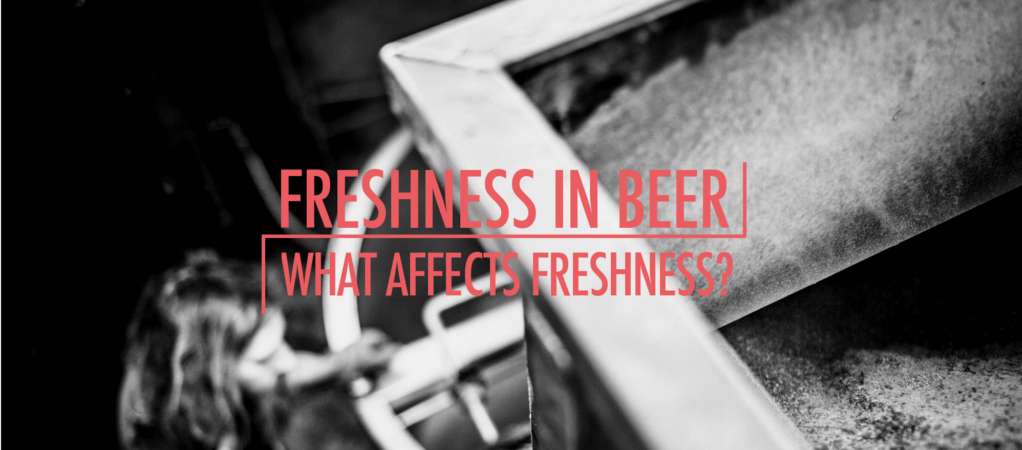Freshness in beer
News
Gipsy Hill 18 July 2017

Freshness in beer should be paramount to any brewery and its customers. Sam has broken down some of the facts on why.
At Gipsy Hill, we’ve just launched an online shop whose whole existence is to get our beers into your hands in as good condition as they can be, so you can enjoy them at their tastiest. We’ve been asked what it takes to drink a beer in peak condition, what that even means and how bad is it if you don’t get it in peak condition? It’s not a dumb question at all. This blog’s going to dig into it a bit.
There are a number of elements to getting peak condition beer (style dependent). The main three elements, at least for hoppy pales, are 1) freshness – how recently was it packaged; 2) stability – how has it been processed and packaged; 3) storage – how has it been stored between packaging and serving.
Freshness
Hoppy pales get stale over time. The same beer drunk a day or two after packaging, vs. in a year will taste different. Some will be straight up stale, others will be ok, some more or less fine. How different they’ll be depends on a variety of things.
So what else makes the difference for hoppy pales?
Stability
A kettle-fined, fermenter-fined, centrifuged, sterile filtered, pasteurised and other processes and additives we don’t even know about, pale will taste as good on day 1 as on day 730. A completely additive and finings-free, uncentrifuged, unfiltered, unpasteurised, natural pale will taste very different on day 1 vs. day 30 vs. 730. Depending on where the pale you’re holding sits on this processing spectrum, will partly dictate the speed of its decline from packaging day.
Gipsy Hill beers are very lightly fined, with vegan-friendly finings, to help pull out the yeast, and make sure we’re allowing our hops and malt to shine. They’re also currently unfiltered, unpasteurised, uncentrifuged and with no other types of finings anywhere else in the process. Our beers will last, but they’re certainly at the unprocessed end of the spectrum.
Packaging
The quality of packaging is vital to shelf life. TPO (Total Packaged Oxygen) is the bain of every brewer’s life. In short, high levels of TPO ruin shelf life and staleness happens much faster. If it’s really bad it can mean that beer lasts just a few weeks before becoming oxidised, characterised (again style dependent) by cardboard, sweet honey, butterscotch (diacetyl). If a brewer can get TPO numbers from 50-200ppb (parts per billion) oxygen levels in a sealed bottle, keg or can, you’re way ahead. If you’re at 1000+ppb, you’ve got an uphill battle as your shelf life is already shot and staleness and oxidation will happen much earlier.
Storage
A hoppy pale that’s stored at 30dC will have a different shelf life to one that’s stored at 5dC. The volatile oils that are in beer, which come from hops, can degrade very quickly. This is why, in incredibly simple terms, putting hops in the boil gets you bitterness, in the whirlpool gets you flavour and in as dry hops gets you aroma (hop varietal depending). The hotter it is, and the longer the contact time with hot wort, the quicker the delicate aroma volatiles evaporate. If you don’t get to the 30dC one quickly (from a few days to a few weeks depending on the stability, packaging and freshness), it will have oxidised and gone stale.
Conclusion
Obviously if you add together the best-case scenario of all of these variables, vs. the worst-case, you land at two very different hoppy pales! What does it all mean then? Well, freshness is written on every bottle with the bottle on date, so take note, adjust it for style and make a call about whether from a freshness perspective it’s in good shape. Get to know how your favourite breweries process and package their beer. Then you can make a judgement about whether a beer that has been sitting on the shelf for a few weeks at 20dC will still be ok as its quite fresh, and was well processed and packaged. Some breweries have been very vocal about their beer being drunk fresh, because they are so unprocessed with so many delicate hop volatiles that despite good packaging and good storage if too much time passes then the beer will not be at its best!
As for us? We just want to make our beer available to you so you have it in the best condition it can be. The freshest, with patented* Gipsy Hill processing, as well packaged as we can (current bottle TPO at circa 120ppb, keg TPO at 75ppb), and stored at 5dC throughout its life until it’s shipped to you.
*it’s not patented, but it’s detailed, come visit us and we’ll tell you 😉